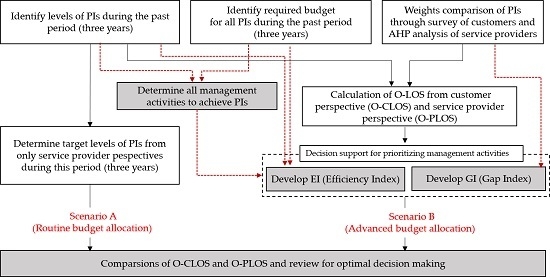Gap Analysis Based Decision Support Methodology to Improve Level of Service of Water Services
Abstract
:1. Introduction
2. Research Approach and Methodology
3. Development of Indices for O-LOS Modeling
3.1. Identification of All Management Activities
3.2. Application of Efficiency Index
3.3. Application of Gap Index
4. Results of O-LOS Modeling
5. Conclusions
Acknowledgments
Author Contributions
Conflicts of Interest
References
- Kleiner, Y.; Sadiq, R.; Rajani, B. Modeling failure risk in buried pipes using fuzzy markov deterioration process. In Proceedings of the ASCE International Conference on Pipeline Engineering and Construction, San Diego, CA, USA, 2–4 August 2004. [Google Scholar]
- Rogers, P.D.; Grigg, N.S. Failure assessment modeling to prioritize water pipe renewal: Two case studies. J. Infrastruct. Syst. 2009, 15, 162–171. [Google Scholar] [CrossRef]
- Baah, K.; Dubey, B.; Harvey, R.; McBean, E. A risk-based approach to sanitary sewer pipe asset management. Sci. Total Environ. 2015, 505, 1011–1017. [Google Scholar] [CrossRef] [PubMed]
- Giustolisi, O.; Laucelli, D.; Savic, D.A. Development of rehabilitation plans for water mains replacement considering risk and cost-benefit assessment. Civ. Eng. Environ. Syst. 2006, 23, 175–190. [Google Scholar] [CrossRef]
- Gaivoronski, A.; Sechi, G.M.; Zuddas, P. Cost/risk balanced management of scarce resources using stochastic programming. Eur. J. Oper. Res. 2012, 216, 214–224. [Google Scholar] [CrossRef]
- Martini, A.; Troncossi, M.; Rivola, A. Leak detection in water-filled small-diameter polyethylene pipes by means of acoustic emission measurements. Appl. Sci. 2017, 7, 2. [Google Scholar] [CrossRef]
- Martini, A.; Troncossi, M.; Rivola, A. Vibroacoustic measurements for detecting water leaks in buried small-diameter plastic pipes. J. Pipeline Syst. Eng. Pract. 2017, 8, 04017022. [Google Scholar] [CrossRef]
- Yazdekhasti, S.; Piratla, K.R.; Atamturktur, S.; Khan, A. Experimental evaluation of a vibration-based leak detection technique for water pipelines. Struct. Infrastruct. Eng. 2017, 13, 1–10. [Google Scholar] [CrossRef]
- Pietrucha-Urbanik, K.; Tchórzewska-Cieslak, B. Water supply system operation regarding consumer safety using kohonen neural network. In Safety, Reliability and Risk Analysis: Beyond the Horizon; Steenbergen, R.D.J.M., van Gelder, P.H.A.J.M., Miraglia, S., Vrouwenvelder, A.C.W.M., Eds.; Taylor & Francis Group: London, UK, 2014; pp. 1115–1120. [Google Scholar]
- TchórzewskA-cieślAk, B. Analysis of the gas network failure and failure prediction using the Monte Carlo simulation method analiza awaryjności sieci gazowych oraz prognozowanie awarii z zastosowaniem symulacyjnej metody Monte Carlo. Eksploatacja I Niezawodnosc 2016, 18, 254. [Google Scholar] [CrossRef]
- Kiwa Water Research (KWR). Consumer Satisfaction, Preference and Acceptance Regarding Drinking Water Services: An Overview of Literature Findings and Assessment Methods; Kiwa Water Research: Nieuwegein, The Netherlands, 2008. [Google Scholar]
- Ojo, V.O. Customer Satisfaction: A Framework for Assessing the Service Quality of Urban Water Service Providers in Abuja, Nigeria. Ph.D. Thesis, Loughborough University, Loughborough, UK, 2011. [Google Scholar]
- Hanson, J.J.; Murrill, S.D. South Tahoe Public Utility District 2012 Customer Satisfaction and Perceptions Survey Report of Results; Meta Research, Inc.: Sequim, WA, USA, 2013. [Google Scholar]
- Levallois, P.; Grondin, J.; Gingras, S. Evaluation of consumer attitudes on taste and tap water alternatives in Québec. Water Sci. Technol. 1999, 40, 135–139. [Google Scholar]
- Lou, J.C.; Lee, W.L.; Han, J.Y. Influence of alkalinity, hardness and dissolved solids on drinking water taste: A case study of consumer satisfaction. J. Environ. Manag. 2007, 82, 1–12. [Google Scholar] [CrossRef] [PubMed]
- Kayaga, S.; Calvert, J.; Sansom, K. Paying for water services: Effects of household characteristics. Util. Policy 2003, 11, 123–132. [Google Scholar] [CrossRef]
- Wahid, N.A.; Hooi, C.K. Factors determining household consumer’s willingness to pay for water consumption in Malaysia. Asian Soc. Sci. 2015, 11. [Google Scholar] [CrossRef]
- Han, S.; Hwang, H.; Kim, S.; Baek, G.S.; Park, J. Sustainable water infrastructure asset management: A gap analysis of customer and service provider perspectives. Sustainability 2015, 7, 13334–13350. [Google Scholar] [CrossRef]
- Tsai, W.H.; Hsu, W.; Chou, W.C. A gap analysis model for improving airport service quality. Total Qual. Manag. Bus. Excell. 2011, 22, 1025–1040. [Google Scholar] [CrossRef]
- Anand, S.V.; Selvaraj, M. Evaluation of service quality and its impact on customer satisfaction in Indian banking sector—A comparative study using SERVPERF. Life Sci. J. 2013, 10, 3267–3274. [Google Scholar]
- Elkington, J. Towards the sustainable corporation: Win-Win-Win Business Strategies for sustainable development. Calif. Manag. Rev. 1994, 36, 90–100. [Google Scholar] [CrossRef]
- Hall, T.J. The triple bottom line: What is it and how does it work? Indiana Bus. Rev. 2011, 86, 4. [Google Scholar]
- Lafferty, A.K.; Lauer, B.; Association, A.W.W. Benchmarking Performance Indicators for Water and Wastewater Utilities: Survey Data and Analyses Report; American Water Works Association: Denver, CO, USA, 2005. [Google Scholar]
- Alegre, H. Performance Indicators for Water Supply Services; IWA Publishing: London, UK, 2006. [Google Scholar]
- Koo, D.H.; Ariaratnam, S.T. Application of a sustainability model for assessing water main replacement options. J. Constr. Eng. Manag. 2008, 134, 563–574. [Google Scholar] [CrossRef]
- Koo, D.H.; Ariaratnam, S.T.; Kavazanjian, E. Development of a sustainability assessment model for underground infrastructure projects. Can. J. Civ. Eng. 2009, 36, 765–776. [Google Scholar] [CrossRef]
- Liner, B.; deMonsabert, S. Balancing the triple bottom line in water supply planning for utilities. J. Water Resour. Plan. Manag. 2011, 137, 335–342. [Google Scholar] [CrossRef]
- Parasuraman, A.; Zeithaml, V.A.; Berry, L.L. A conceptual model of service quality and its implications for future research. J. Mark. 1985, 49, 41–50. [Google Scholar] [CrossRef]
- Carman, J.M. Consumer perceptions of service quality: An assessment of the servqual dimensions. J. Retail. 1990, 66, 33–55. [Google Scholar]
- Cronin, J.J., Jr.; Taylor, S.A. Measuring service quality: A reexamination and extension. J. Mark. 1992, 56, 55–68. [Google Scholar] [CrossRef]
- NAMS Group. International Infrastructure Management Manual; NZ National Asset Management Steering Group (NAMS), Association of Local Government Engineers New Zealand: Thames, New Zealand, 2006. [Google Scholar]
- NAMS Group. Developing Levels of Service and Performance Measures; NZ National Asset Management Steering Group (NAMS), Association of Local Government Engineers New Zealand: Thames, New Zealand, 2007. [Google Scholar]
- Han, S.; Chae, M.; Hwang, H.; Choung, Y. Evaluation of customer-driven level of service for water infrastructure asset management. J. Manag. Eng. 2014, 31, 04014067. [Google Scholar] [CrossRef]
- BusinessDictionary. Available online: http://www.businessdictionary.com/definition/cost-performance-index-CPI.html (assessed on 15 July 2017).
- Ministry of Environment in Korea. Statistical Yearbook for Water Service in 2012; Ministry of Environment: Seoul, Korea, 2014.
- Ministry of Environment in Korea. Statistical Yearbook for Water Service in 2013; Ministry of Environment: Seoul, Korea, 2015.
- Ministry of Environment in Korea. Statistical Yearbook for Water Service in 2008; Ministry of Environment: Seoul, Korea, 2010.
- Ministry of Environment in Korea. Statistical Yearbook for Water Service in 2009; Ministry of Environment: Seoul, Korea, 2011.
- Ministry of Environment in Korea. Statistical Yearbook for Water Service in 2010; Ministry of Environment: Seoul, Korea, 2012.
- Ministry of Environment in Korea. Statistical Yearbook for Water Service in 2011; Ministry of Environment: Seoul, Korea, 2013.
- The Office of Waterworks Seoul Metropolitan Government. Management Information Regarding Financial Statements. Available online: http://arisu.seoul.go.kr/c5/sub3_1.jsp (assessed on 15 July 2017).
- United States Environmental Protection Agency (USEPA). The Clean Water and Drinking Water Infrastructure Gap Analysis; EPA-816-R-02-020; USEPA: Washington, DC, USA, 2002.
- Graf, W. Assessing Utility Practices with the Strategic Asset Management Gap Analysis Tool (SAM Gap); SAM2C06; Water Research Foundation: Denver, CO, USA, 2010. [Google Scholar]
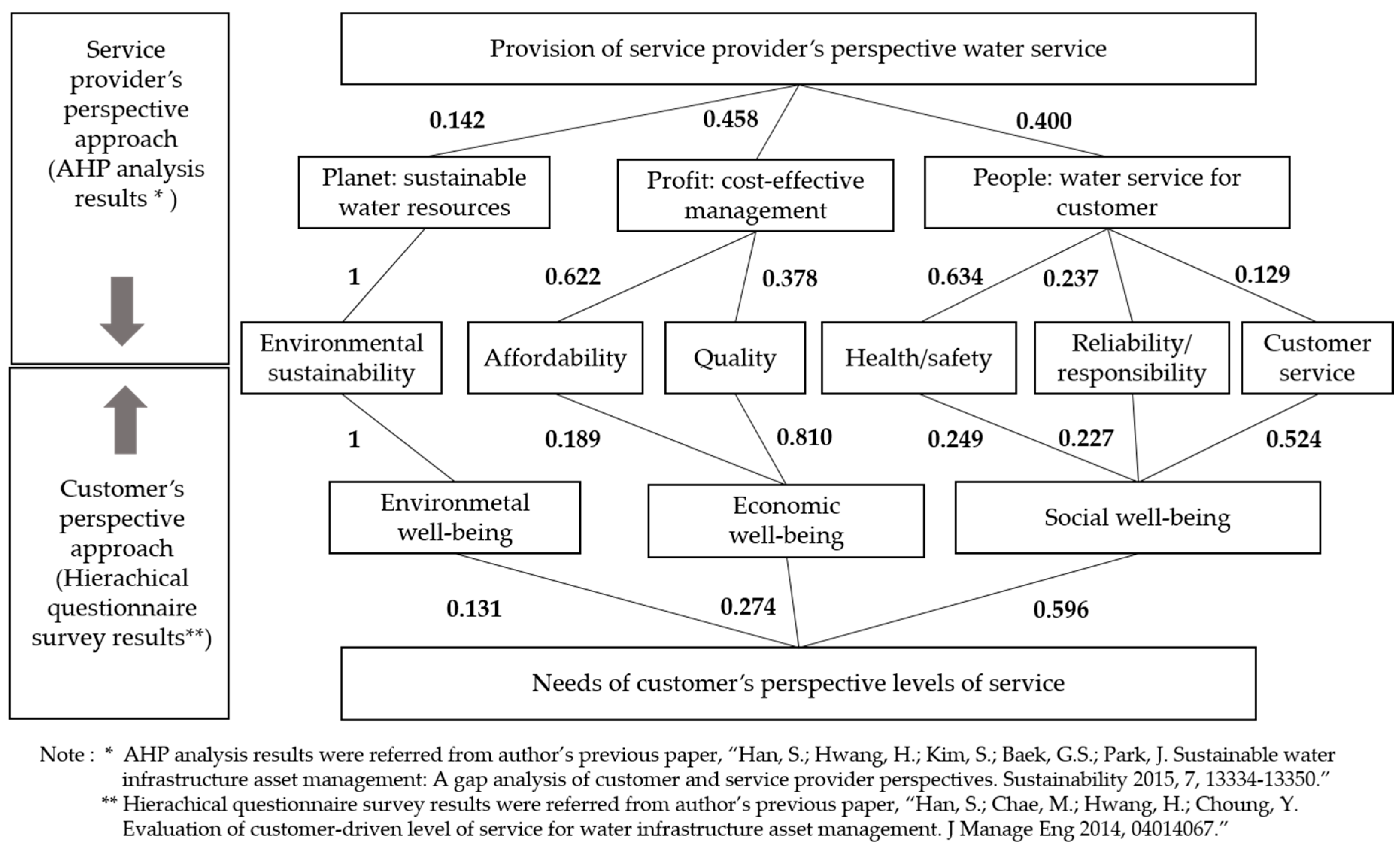
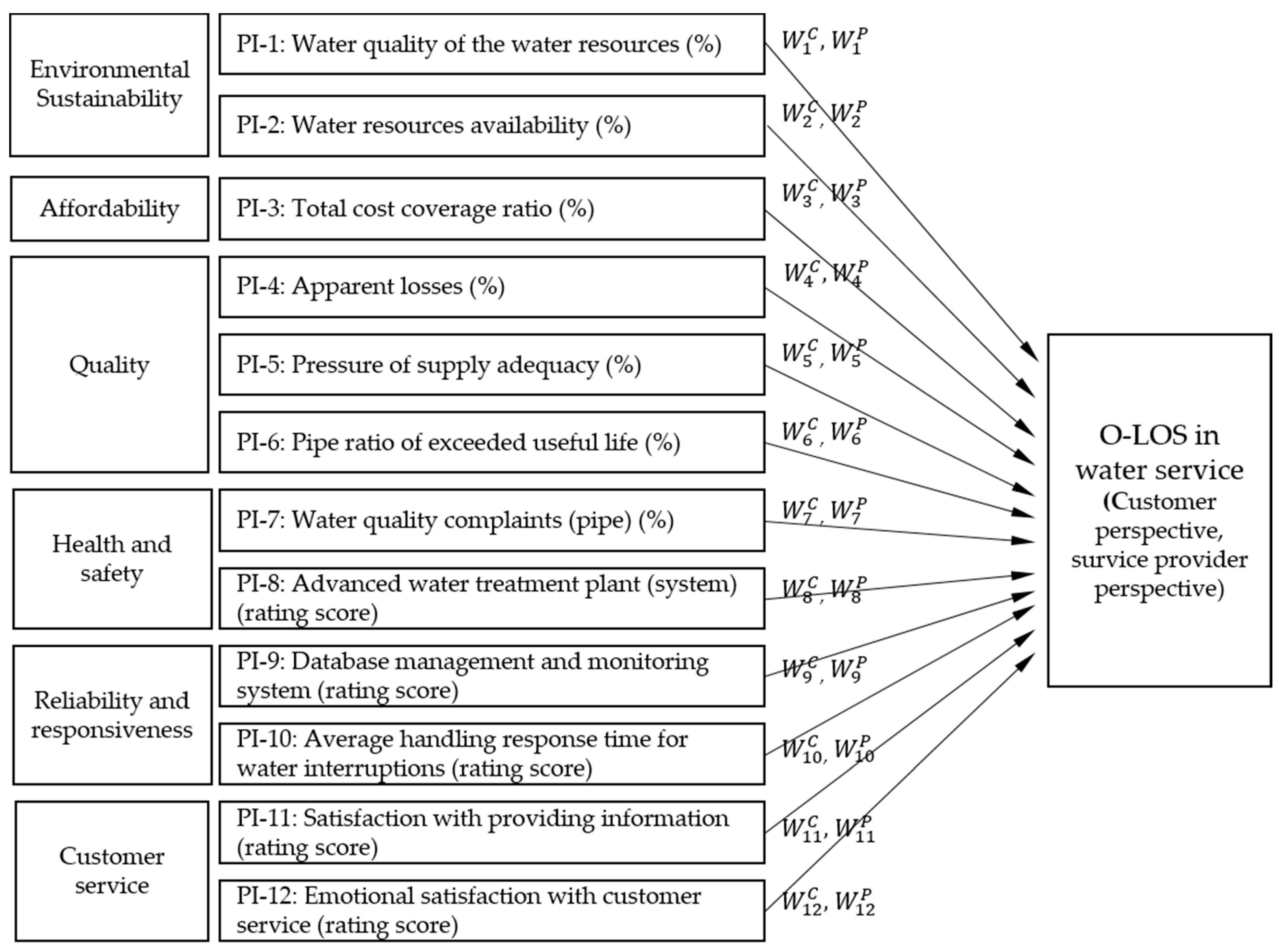
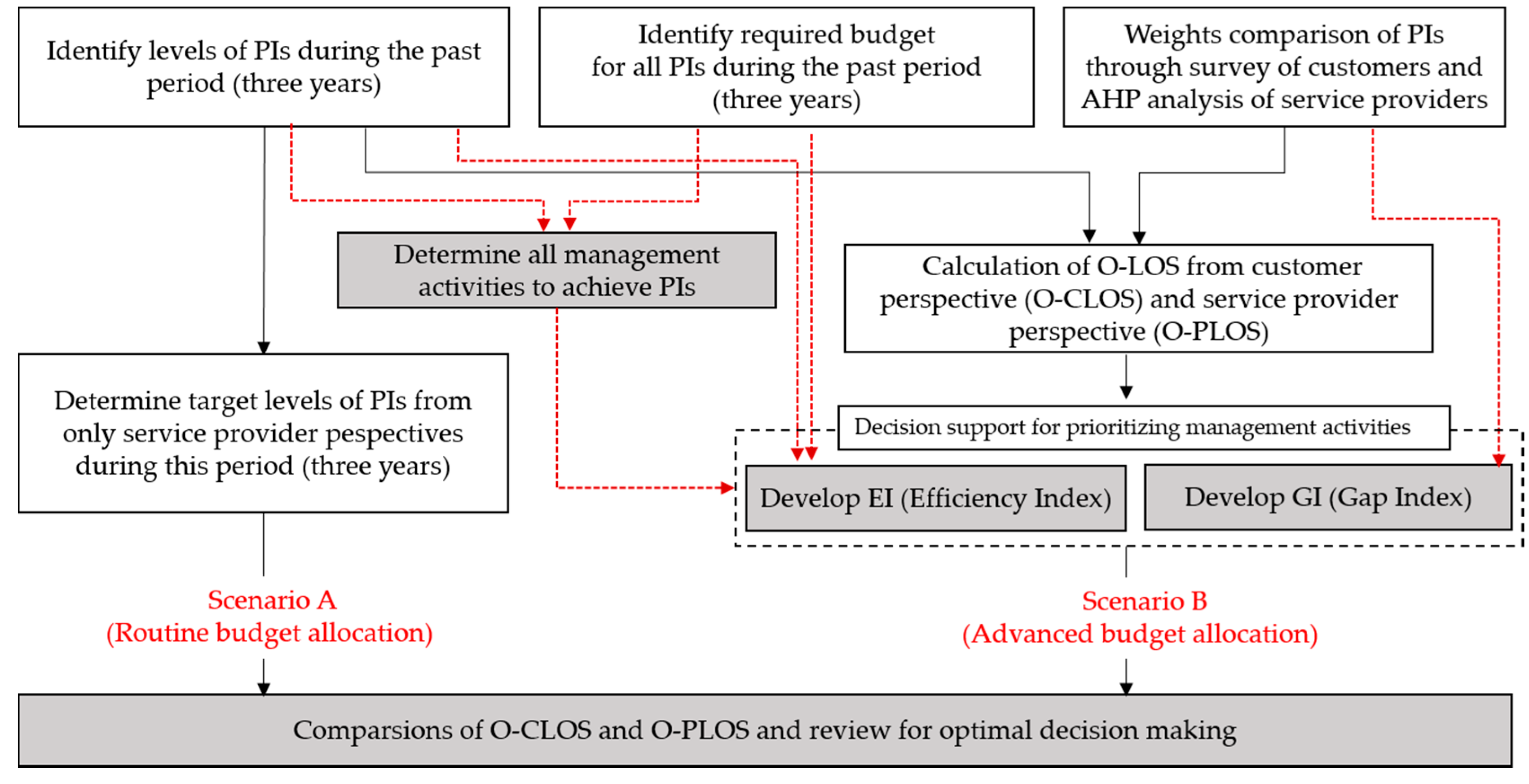
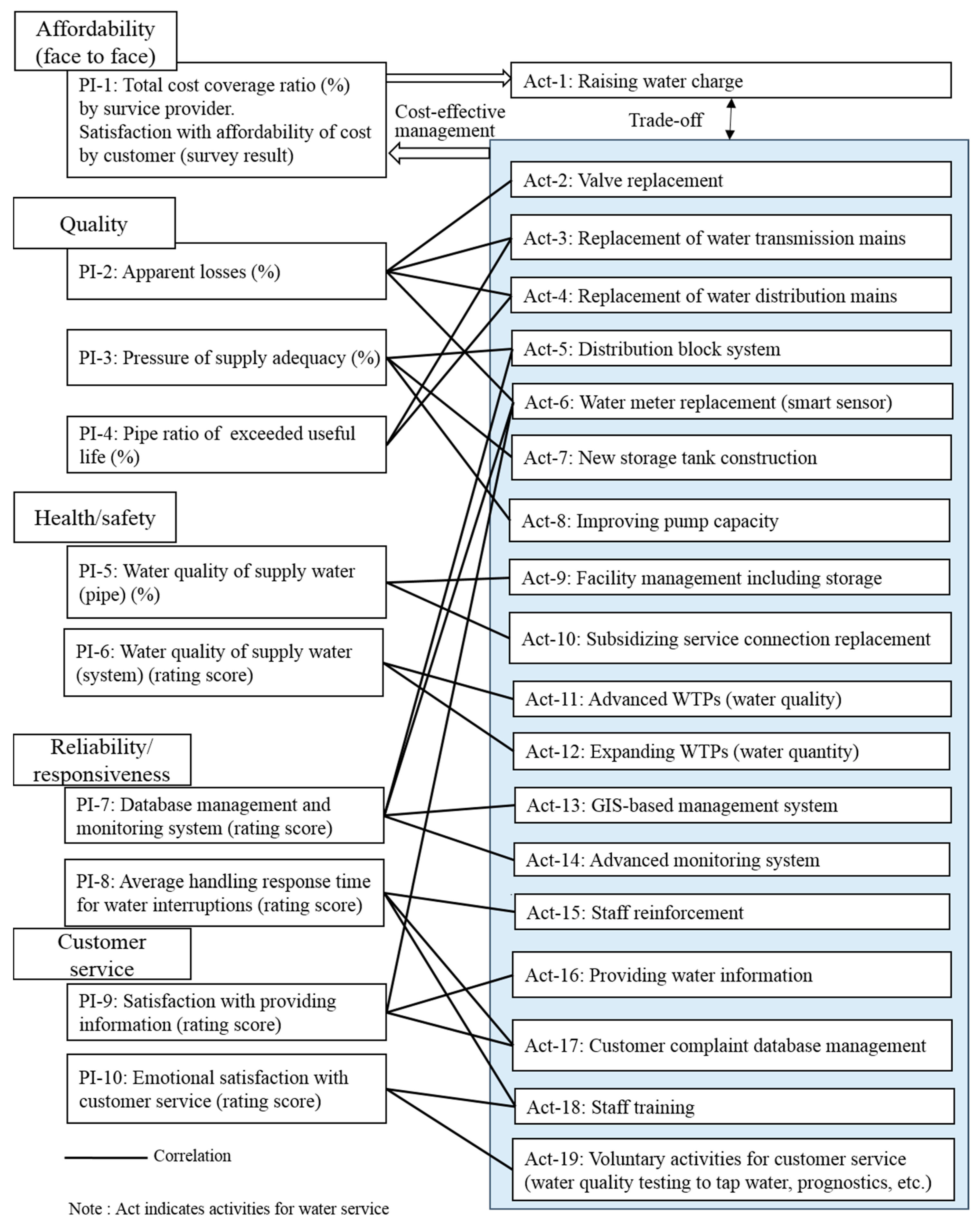
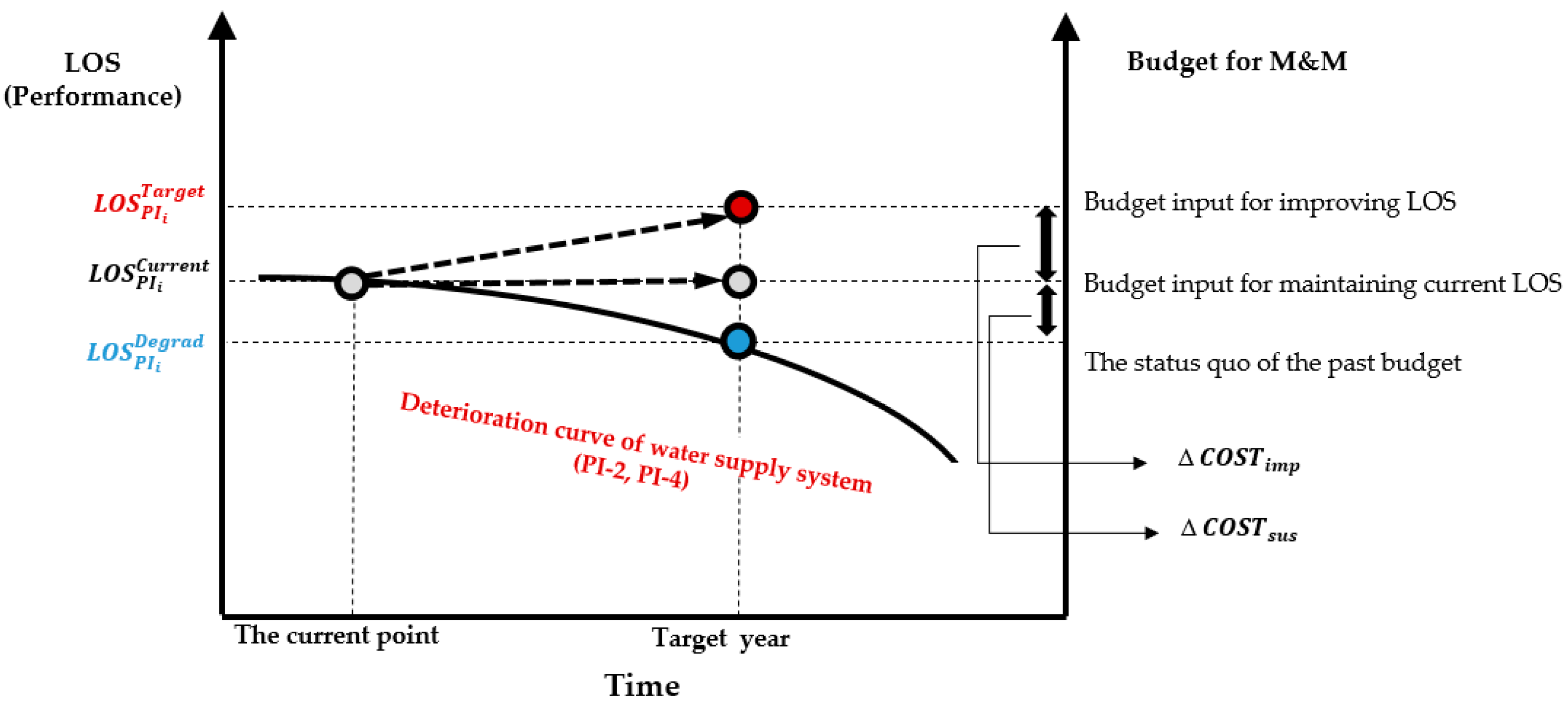
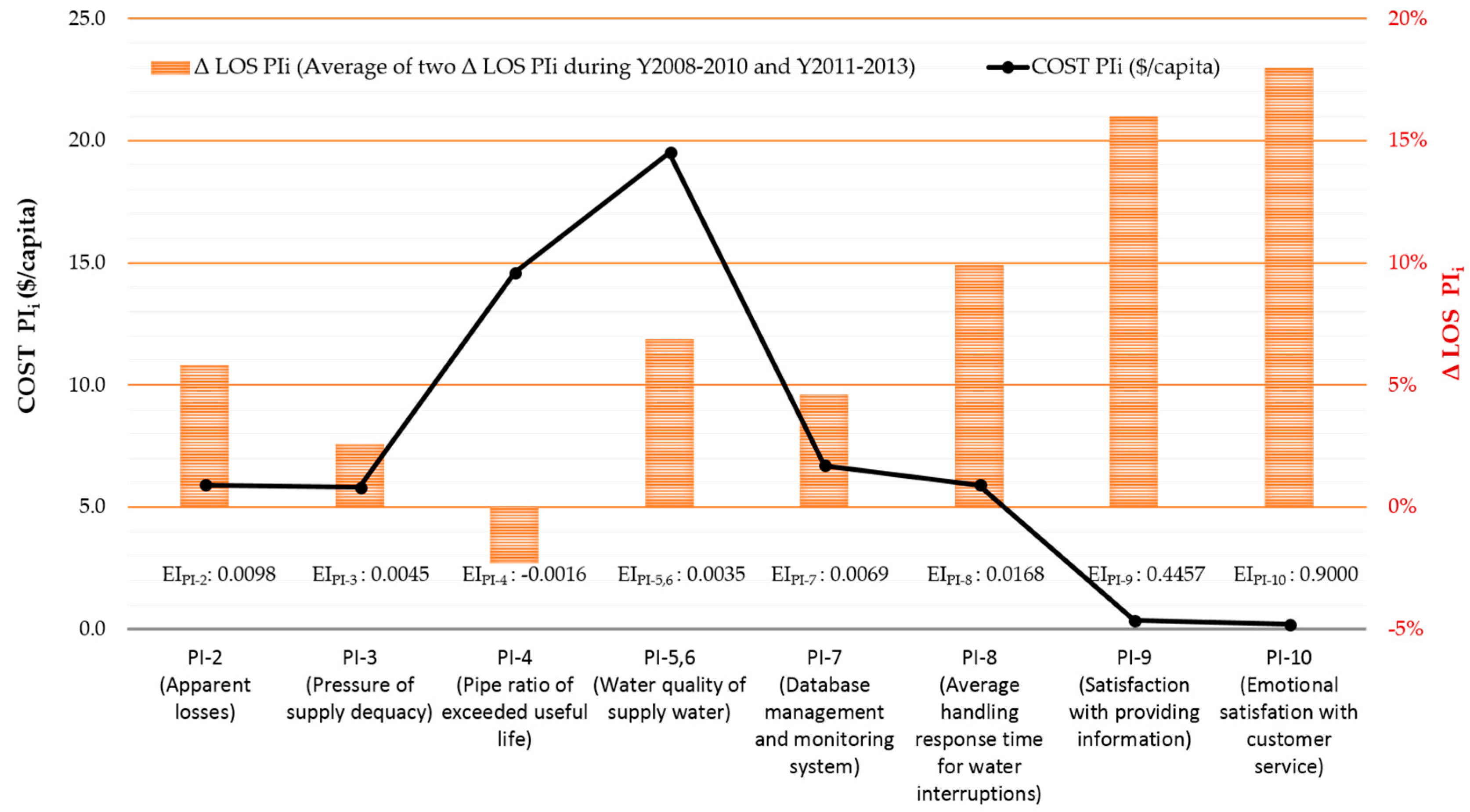

| Cities | Apparent Losses |
|---|---|
| Seoul-City (metropolitan) | 6.2% |
| Busan-City (metropolitan) | 9.1% |
| Daegu-City (metropolitan) | 12.4% |
| Incheon-City (metropolitan) | 12.8% |
| Gwangju-City (metropolitan) | 17.2% |
| Daejeon-City (metropolitan) | 13.5% |
| Ulsan-City (metropolitan) | 12.4% |
| Kapeong-Gun (Gyeonggi-Do) | 23.4% |
| Taebaek-City (Kangwon-Do) | 55.4% |
| Buyeo-Gun (Chungcheongnam-Do) | 39.2% |
| Wanju-Gun (Cheonlabuk-Do) | 32.6% |
| Jindo-Gun (Cheonlanam-Do) | 45.4% |
| Gosung-Gun (Gyeongsangnam-Do) | 39.8% |
| PIs | Factors (Weights) | ||||||||||
|---|---|---|---|---|---|---|---|---|---|---|---|
| PI-7: Database management and monitoring system | Distribution block system (0.3) | GIS-based management (0.3) | Water metering automation (0.3) | Advanced monitoring system (0.1) | |||||||
| PI-9: Satisfaction of providing information | Asset management plan (0.15) | Water quality information (0.20) | Announcement of planned water interruptions (0.10) | DB management of complaints (0.15) | Water charge calculation (0.10) | Survey of customer service (0.10) | Process of requiring to water service (0.10) | Statistics of water services (0.05) | Financial statements (0.03) | Bidding information (0.02) | |
| PI-10: Emotional satisfaction of customer service | Staff education (0.4) | Water quality testing to tap-water (0.3) | Water metering automation (0.1) | Voluntary response for the rapid water consumption (pipe leakage) (0.1) | Follow-up management (0.1) | ||||||
| PIs | Gap among Utilities | Gap between Customer and Service Provider | ( | Ranking PIs | |
|---|---|---|---|---|---|
| PI-1: Total cost coverage ratio/Affordability of cost | 87.5 | 0.317 | 0.062 | 5.843 | N/A |
| PI-2: Apparent losses | 88.8 | 0.032 | 0.049 | 0.735 | 8 |
| PI-3: Water pressure complaints | 78.7 | 0.072 | 0.056 | 1.634 | 4 |
| PI-4: Pipe ratio of exceeded useful life | 92.9 | 0.118 | 0.099 | 1.281 | 6 |
| PI-5, PI-6: Water quality of supplied water (Pipe and WTP) | 66.0 | 0.148 | 0.165 | 1.359 | 5 |
| PI-7: Reliability and responsibility (system) | 65.9 | 0.040 | 0.076 | 0.799 | 7 |
| PI-8: Reliability and responsibility (organization) | 63.1 | 0.096 | 0.051 | 2.983 | 3 |
| PI-9: Satisfaction with providing information | 49.0 | 0.162 | 0.036 | 9.184 | 2 |
| PI-10: Emotional satisfaction with customer service | 43.0 | 0.150 | 0.036 | 9.690 | 1 |
| PIs | Weights of Customer Perspective (Wc) | Weights of Service Provider Perspective (Wp) | (2010) | (2013) |
|---|---|---|---|---|
| PI-1 | 0.052 | 0.317 | 74.1 */87.5 ** | 70.4 */92.8 ** |
| PI-2 | 0.032 | 0.049 | 88.8 | 94.6 |
| PI-3 | 0.072 | 0.056 | 78.7 | 81.3 |
| PI-4 | 0.118 | 0.099 | 92.9 | 90.6 |
| PI-5,6 | 0.148 | 0.165 | 66.0 | 72.9 |
| PI-7 | 0.04 | 0.076 | 65.9 | 70.5 |
| PI-8 | 0.095 | 0.051 | 63.1 | 73.0 |
| PI-9 | 0.162 | 0.036 | 49.0 | 65.0 |
| PI-10 | 0.15 | 0.036 | 43.0 | 61.0 |
| PIs | (2013) | GI Ranking | EI Ranking | The Past Allocated Budget (2011–2013) | Budget Allocation Scenario (2014–2016) | Prioritizing Budget Allocation (see Table Foot Note for Star(s)) | |
|---|---|---|---|---|---|---|---|
| Scenario A (Routine Budget Allocation) | Scenario B (Advance Budget Allocation ) | ||||||
| PI-2 | 0.946 | 8 | 4 | $43,589,514 | $50,127,941 | $45,115,147 | ★ |
| PI-3 | 0.813 | 4 | 7 | $9,388,511 | $10,796,787 | $13,495,984 | ★★★ |
| PI-4 | 0.906 | 5 | 8 | $84,496,597 | $97,171,086 | $92,312,532 | ★ |
| PI-5,6 | 0.729 | 6 | 6 | $119,368,208 | $137,273,439 | $130,409,767 | ★★ |
| PI-7 | 0.705 | 7 | 5 | $48,283,769 | $55,526,335 | $55,526,335 | ★★ |
| PI-8 | 0.730 | 3 | 3 | $12,607,429 | $14,498,543 | $23,197,669 | ★★★★ |
| PI-9 | 0.650 | 1 | 2 | $3,353,040 | $3,855,995 | $7,711,991 | ★★★★★ |
| PI-10 | 0.610 | 2 | 1 | $1,247,331 | $1,434,430 | $2,868,861 | ★★★★★ |
| Sum | $322,334,398 | $370,684,557 | $370,638,285 | ||||
© 2017 by the authors. Licensee MDPI, Basel, Switzerland. This article is an open access article distributed under the terms and conditions of the Creative Commons Attribution (CC BY) license (http://creativecommons.org/licenses/by/4.0/).
Share and Cite
Han, S.; Koo, D.D.; Kim, Y.; Kim, S.; Park, J. Gap Analysis Based Decision Support Methodology to Improve Level of Service of Water Services. Sustainability 2017, 9, 1578. https://doi.org/10.3390/su9091578
Han S, Koo DD, Kim Y, Kim S, Park J. Gap Analysis Based Decision Support Methodology to Improve Level of Service of Water Services. Sustainability. 2017; 9(9):1578. https://doi.org/10.3390/su9091578
Chicago/Turabian StyleHan, Sangjong, Dan Daehyun Koo, Youngkyung Kim, Seonghoon Kim, and Joonhong Park. 2017. "Gap Analysis Based Decision Support Methodology to Improve Level of Service of Water Services" Sustainability 9, no. 9: 1578. https://doi.org/10.3390/su9091578




